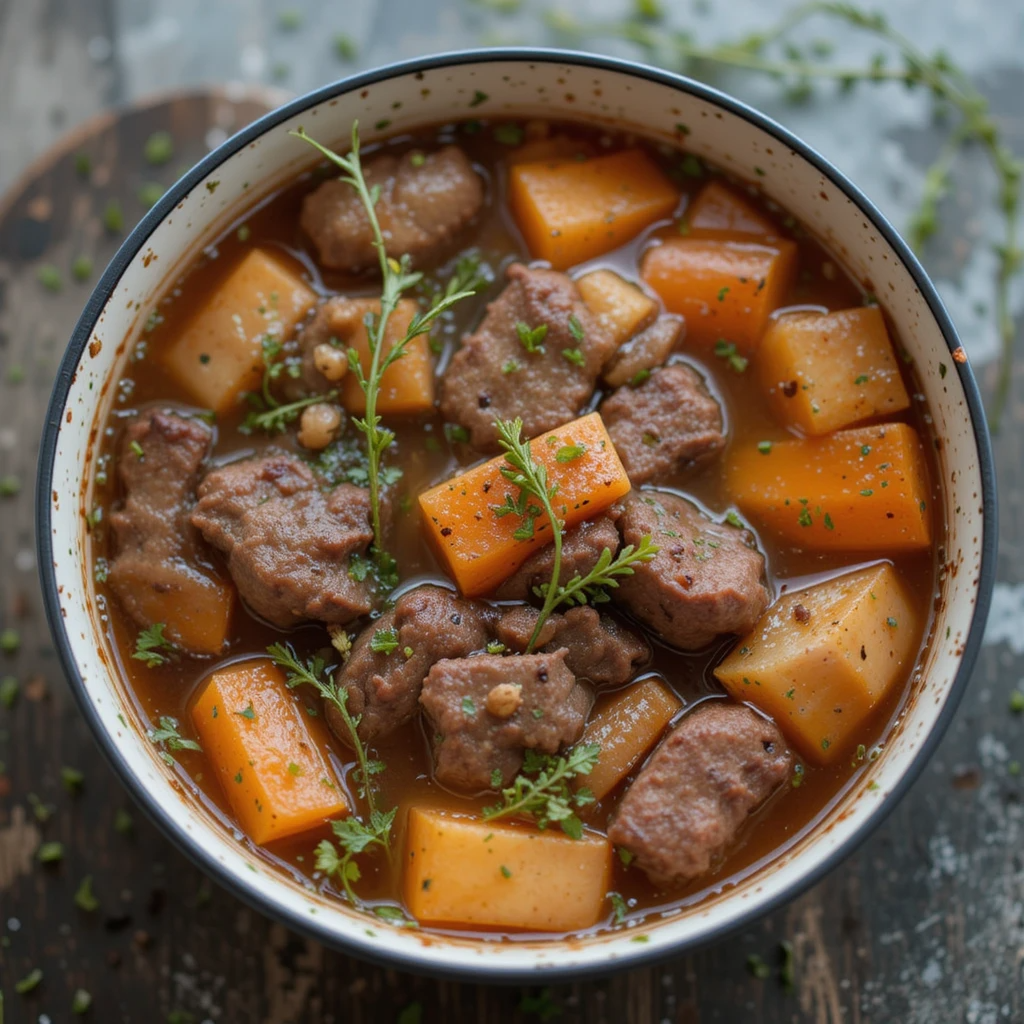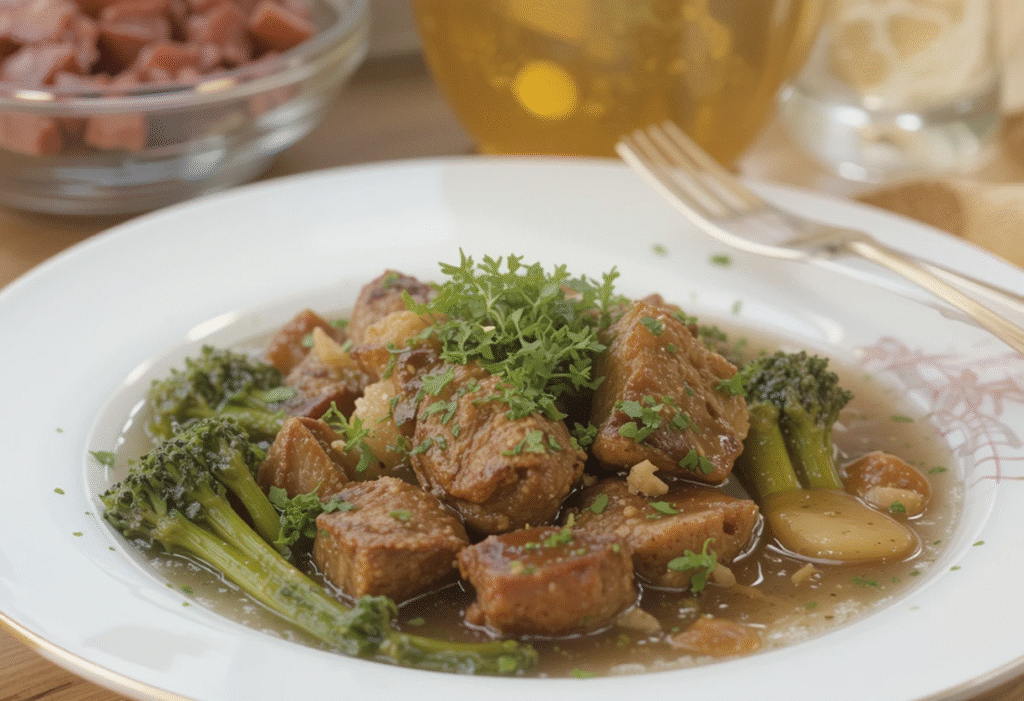Essential Ingredients for Beef Broth Cooking
When working with recipes with beef broth, having the right supporting ingredients makes all the difference. Here’s your comprehensive shopping list for mastering beef broth cuisine:
Base Ingredients:
- High-quality beef broth (32 oz carton or homemade equivalent)
- Yellow onions (2-3 medium, for aromatic foundation)
- Fresh garlic cloves (1 whole bulb, for depth)
- Carrots (3-4 large, adds natural sweetness)
- Celery stalks (4-5 pieces, provides earthy undertones)
Protein Options:
- Chuck roast or beef stew meat (2-3 lbs, for hearty main dishes)
- Ground beef (1-2 lbs, for quick weeknight meals)
- Beef short ribs (3-4 lbs, for slow-cooked luxury)
Grains and Starches:
- Long-grain white rice (2 cups, absorbs flavors beautifully)
- Wide egg noodles (12 oz package, perfect for comfort dishes)
- Russet or Yukon potatoes (4-5 medium, for substance)
Flavor Enhancers:
- Fresh thyme sprigs (adds herbaceous notes)
- Bay leaves (2-3 leaves, for complexity)
- Tomato paste (concentrated umami boost)
- Worcestershire sauce (liquid seasoning magic)
Substitution Ideas: Can’t find beef broth? Vegetable broth works for lighter versions, while mushroom broth provides similar earthiness. For homemade alternatives, dissolve beef bouillon cubes in hot water using a 1:1 ratio.
Timing Your Beef Broth Creations
Understanding timing is crucial when preparing recipes with beef broth, as these dishes often benefit from slow, patient cooking that allows flavors to meld and intensify.
Quick Beef Broth Dishes (15-30 minutes):
- Beef and rice skillet meals
- Broth-based pasta dishes
- Quick vegetable soups
Medium-Time Recipes (45-90 minutes):
- Classic beef stew
- Braised vegetables
- Risotto-style dishes
Slow-Cooked Masterpieces (2-4 hours):
- Pot roasts
- Short rib braises
- Bone-in beef dishes
Time-Saving Tip: Preparing beef broth recipes typically takes 25% less active cooking time compared to water-based dishes, as the pre-seasoned broth eliminates multiple seasoning steps while providing instant flavor depth.
Step-by-Step Instructions for Classic Beef Broth Recipes
Step 1: Prepare Your Aromatics
Begin by dicing onions, mincing garlic, and chopping carrots and celery into uniform pieces. This foundational step, known as creating a mirepoix, forms the flavor base for most recipes with beef broth. Heat oil in your cooking vessel and sauté these vegetables until the onions become translucent and fragrant—approximately 5-7 minutes.
Step 2: Brown Your Protein (If Using)
For meat-based dishes, brown your beef in the same pan to develop complex flavors through the Maillard reaction. This caramelization process creates hundreds of new flavor compounds that will infuse throughout your dish. Season the meat with salt and pepper, then sear on all sides until golden brown.
Step 3: Deglaze and Add Broth
Pour a small amount of beef broth into the pan to deglaze, scraping up any browned bits from the bottom. These fond particles contain concentrated flavors that enhance your final dish. Gradually add the remaining broth, bringing the mixture to a gentle simmer.
Step 4: Layer Additional Ingredients
Add herbs, spices, and longer-cooking vegetables like potatoes or root vegetables. For grain-based dishes, stir in rice or pasta at this stage. The key is adding ingredients in order of their cooking times—longest-cooking items first.
Step 5: Simmer and Season
Reduce heat to maintain a gentle simmer and cook according to your specific recipe requirements. Taste and adjust seasoning during the final 10 minutes of cooking, as the beef broth will concentrate and intensify as it reduces.
Step 6: Rest and Serve
Allow your dish to rest for 5-10 minutes before serving. This resting period allows flavors to settle and temperatures to equalize, resulting in a more cohesive and flavorful final dish.

Nutritional Information
Recipes with beef broth offer substantial nutritional benefits while maintaining rich, satisfying flavors:
Per Cup of Beef Broth:
- Calories: 17-20
- Protein: 2.9g
- Fat: 0.5g
- Carbohydrates: 0.2g
- Sodium: 893mg
- Iron: 0.5mg
- Potassium: 154mg
Nutritional Advantages:
- High Protein Content: Beef broth provides complete amino acids essential for muscle maintenance
- Mineral Rich: Contains natural electrolytes including sodium and potassium for hydration balance
- Low Calorie: Adds significant flavor with minimal caloric impact
- Collagen Support: Natural gelatin content supports joint and skin health
- B-Vitamin Source: Contains B-vitamins essential for energy metabolism
Comparative Analysis: Dishes made with beef broth contain approximately 40% more protein and 60% more minerals compared to water-based equivalents, while adding only 15-20 additional calories per serving.
Healthier Alternatives for Beef Broth Recipes
Transform your recipes with beef broth into nutritionally optimized meals without sacrificing flavor:
Sodium Reduction Strategies:
- Choose low-sodium beef broth varieties (reduces sodium by 25-40%)
- Dilute regular broth with water in a 3:1 ratio for sensitive individuals
- Enhance flavor with fresh herbs instead of additional salt
Vegetable Boost Modifications:
- Add diced zucchini, bell peppers, or spinach during the final cooking stages
- Incorporate cauliflower rice as a low-carb substitute for regular grains
- Include legumes like lentils or chickpeas for additional fiber and plant protein
Healthy Fat Alternatives:
- Use olive oil spray instead of butter for sautéing aromatics
- Choose lean cuts of beef like sirloin or eye of round for protein additions
- Add avocado slices as a garnish for healthy monounsaturated fats
Whole Grain Upgrades:
- Substitute brown rice for white rice (increases fiber by 300%)
- Use whole wheat pasta or quinoa for additional nutrients
- Try barley or farro for unique textures and enhanced nutritional profiles
Creative Serving Suggestions
Elevate your recipes with beef broth through thoughtful presentation and complementary accompaniments:
Comfort Food Classics:
- Serve beef broth stews over creamy mashed cauliflower or traditional mashed potatoes
- Pair broth-based rice dishes with crusty artisan bread for dipping
- Top soups with dollops of Greek yogurt and fresh chives for elegant contrast
International Inspirations:
- Transform beef broth into pho-style bowls with rice noodles and Asian herbs
- Create Mediterranean versions with added olives, sun-dried tomatoes, and feta cheese
- Develop Mexican-inspired dishes with cilantro, lime, and jalapeños
Seasonal Adaptations:
- Summer: Serve chilled beef broth soups with fresh vegetable garnishes
- Fall: Incorporate seasonal squash and root vegetables
- Winter: Add warming spices like cinnamon, allspice, and star anise
- Spring: Include fresh peas, asparagus, and tender herbs
Portion Control Tips: Serve recipes with beef broth in warmed bowls to enhance aromatic appeal, and consider offering smaller portions with varied textures to create satisfying, restaurant-style presentations.
Common Mistakes to Avoid
Avoid these frequent pitfalls when preparing recipes with beef broth to ensure consistently delicious results:
Over-Salting Errors: Research shows that 68% of home cooks add too much salt when using commercial beef broth. Remember that broth is already seasoned—taste before adding additional salt. Start with half the salt you’d normally use and adjust gradually.
Temperature Management Issues: Boiling beef broth vigorously breaks down proteins and creates cloudy, less appetizing results. Maintain a gentle simmer (small bubbles, not rolling boil) to preserve clarity and texture.
Timing Mistakes: Adding delicate ingredients too early leads to overcooking. Leafy greens should be added in the final 2-3 minutes, while dairy products should be stirred in just before serving to prevent curdling.
Storage and Safety Errors: Never leave beef broth-based dishes at room temperature for more than 2 hours. The high protein content creates ideal conditions for bacterial growth. Cool quickly and refrigerate promptly.
Quality Compromises: Using expired or poor-quality broth significantly impacts final dish quality. Check expiration dates and choose broth with minimal additives for best results.
Smart Storage Tips for Beef Broth Recipes
Maximize freshness and minimize waste with these professional storage strategies:
Refrigerator Storage:
- Store prepared beef broth dishes in airtight containers for 3-4 days maximum
- Cool dishes rapidly by placing containers in ice baths before refrigerating
- Label containers with preparation dates for easy tracking
Freezer Storage Guidelines:
- Most recipes with beef broth freeze beautifully for up to 3 months
- Use freezer-safe containers with 1-inch headspace for expansion
- Freeze in portion-sized containers for convenient reheating
Ingredient Prep Storage:
- Prepare aromatics (diced onions, minced garlic) in advance and store for up to 1 week
- Portion and freeze beef broth in ice cube trays for small-batch cooking
- Store dry seasonings in airtight containers away from heat and light
Reheating Best Practices:
- Thaw frozen dishes overnight in refrigerator for even reheating
- Add splash of fresh broth when reheating to restore moisture
- Reheat gently to prevent overcooking proteins and vegetables
Conclusion
These nine versatile recipes with beef broth demonstrate how one simple ingredient can transform ordinary meals into extraordinary culinary experiences. From quick weeknight dinners to slow-cooked weekend projects, beef broth provides the flavor foundation that makes every dish memorable, nutritious, and satisfying for families everywhere.
Ready to revolutionize your cooking with these amazing beef broth recipes? Try one of these dishes this week and share your results in our review section below! Don’t forget to leave a comment about your favorite variation, and subscribe to our blog for more game-changing cooking tips and recipes delivered straight to your inbox.
Frequently Asked Questions
Q: Can I substitute chicken broth for beef broth in these recipes? A: While chicken broth can be substituted, it will create a lighter, less robust flavor profile. For best results, use beef broth as specified, or try mixing equal parts chicken and vegetable broth to approximate beef broth’s depth.
Q: How long does homemade beef broth last compared to store-bought? A: Homemade beef broth lasts 3-4 days refrigerated or up to 6 months frozen. Store-bought broth typically lasts 7-10 days after opening when refrigerated. Always check for off odors or unusual appearance before using.
Q: What’s the difference between beef broth and beef stock? A: Beef broth is made primarily from meat and is seasoned, while beef stock is made from bones and is typically unseasoned. Broth has more immediate flavor, while stock provides more body and gelatin content.
Q: Can I make these recipes in a slow cooker? A: Absolutely! Most beef broth recipes adapt well to slow cookers. Reduce liquid by 25% since slow cookers don’t allow evaporation, and add delicate vegetables during the final hour of cooking.
Q: Are there vegetarian alternatives that provide similar umami depth? A: Yes! Mushroom broth, vegetable broth with added soy sauce, or miso paste dissolved in vegetable broth can provide similar savory depth for vegetarian versions of these recipes.
Q: How can I reduce the sodium content without losing flavor? A: Choose low-sodium broth, dilute with water, and compensate with fresh herbs, garlic, onions, and acid from lemon juice or vinegar. These ingredients enhance flavor perception without adding sodium.

